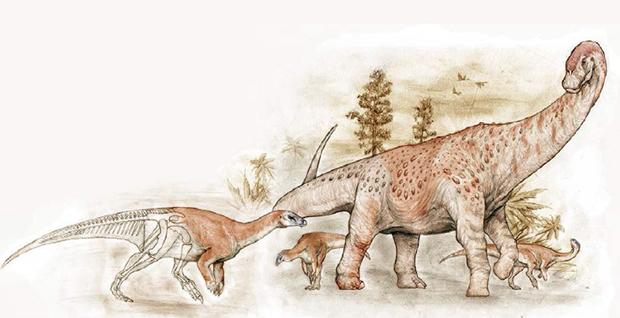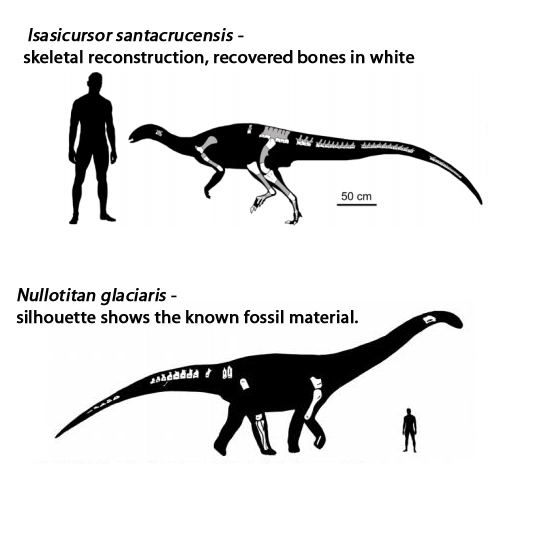Scientists Map out the Late Cretaceous Biota of the Chorrillo Formation (Patagonia)
Scientists meeting at the end of year conference of the Argentine Museum of Natural Sciences have presented a new paper that provides an insight into the vertebrate biota associated with the Chorrillo Formation in the Province of Santa Cruz (Patagonia, southern Argentina). Two new dinosaurs have been described, a basal member of the Iguanodontia estimated to have measured around four metres in length and a much bigger dinosaur, a titanosaur that is estimated to have measured around twenty-five metres long.
Numerous fossil fragments representing several individuals have been found indicating that the iguanodont material might represent a small herd of animals that died together. This dinosaur has been named Isasicursor santacrucensis, whilst the titanosaur has been named Nullotitan glaciaris.
Two New Dinosaurs were Named at the Conference
Picture credit: CONICET
“Los Dinosaurios del fin del Mundo”
All the fossil material examined in the scientific paper, the dinosaur remains, fossilised titanosaur eggshells, fossils associated with other reptiles including a mosasaur, come from an area of approximately 2,000 square metres.
The sequential strata associated with this part of the Chorrillo Formation plot a gradual ingression of the sea eating into a coastal environment. The dinosaurs are believed to have lived around 70 million years ago (Maastrichtian faunal stage of the Cretaceous). As these fossils date from near the end of the Age of Dinosaurs and are geographically located in the south of Argentina, the researchers dubbed them as “Los dinosaurios del fin del mundo” – the dinosaurs from the end of the world.
Silhouette Reconstructions of Isasicursor and Nullotitan
Picture credit: CONICET
An Enormous Femur
Nullotitan fossil material consists of fragmentary elements from the tail (caudal vertebrae), along with a single neck bone (cervical vertebra), portions of the limbs and other scrappy fossil material. The largest, most complete fossil bone is a humerus (upper arm bone), it measures 114 cm long, but both the distal and proximal ends of an enormous femur (thigh bone) were also recovered from the site. The femur is estimated to have been around 190 centimetres in length.
The scientists also reported fragments of theropod eggshells as well as evidence of the presence of both large and small members of the Megaraptoridae, although no fossils associated with abelisaurs were found. Remains of fishes, lizards, turtles and snakes were also identified along with fossil wood and a large number of terrestrial and freshwater snails.
Mammals were present in the ecosystem, two isolated vertebrae belonging to a small mammal were found. The fossil material representing individual animals might be quite poor and scrappy in nature, but the number of fossil finds has greatly improved our understanding of the biota of the southern tip of Patagonia close to the K-Pg boundary that marks the end of the Cretaceous.
Fossil Material Ascribed to Isasicursor santacrucensis
Picture credit: CONICET
View the Everything Dinosaur website: Everything Dinosaur.









Leave A Comment